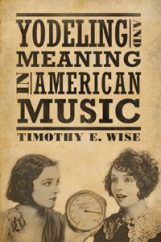Only for very short periods of time have yodeling and yodeling artists received critical attention and commercial success in the US. For most people, yodeling is not even close to singing; although the two forms of musical expression are very similar in a number of ways.
 And there are accounts of yodeling in (European) literature that date back to the late 18th century. The book at hand takes a long and very close look at the history of yodeling in the United States, going backward into the 19th century and musical genres as different as classical singing, vaudeville, blues, country music and Tin Pan Alley songs.
And there are accounts of yodeling in (European) literature that date back to the late 18th century. The book at hand takes a long and very close look at the history of yodeling in the United States, going backward into the 19th century and musical genres as different as classical singing, vaudeville, blues, country music and Tin Pan Alley songs.
Since apart from the regions that may come to mind first in the context of yodeling, Alpine regions of Germany, Italy and Switzerland, also cultures in Africa and Hawaii used the yodel to communicate or sing. However, yodeling was (unfortunately) never conceived of as a form of musical action in classical music. Rather, the yodel initially was a special kind of work song, that signaled arrivals of cattle herds in Alpine regions or sometimes was used to command the animals too. Yodeling originally also was a herding call, while in American music in the 20th Century “… it is most commonly associated with romantically conceived personae, such as the singing hobo or the yodeling cowboy.”
The yodeling form that had the biggest influence on English-language yodeling styles is a Swiss variation of the yodel, namely the “Jodellied” (yodel song), that surfaced around the turn of the 19th century. In this musical form the so-called “stylized yodel,” entire words and not just syllables, nonsensical vocal-consonant combinations, or single characters are performed.
Probably the reason for the little coverage of the art form (as it is still something that must be learned and trained) in the US was the sharp and at times aggressive distinction of the influential enthusiasts of classical music early in the history of the yodel. (Even though there was a very brief period when yodeling was actually used in classical music). And since yodeling was connected to peasants and simple, rude and rowdy people, there was no way to incorporate this form of musical expression into a context of classical European singing. And over the course of the 19th century, when a vast discussion over what was to be labeled art music and what was not occurred, the “novelty” styles clearly were reproached by those interested in refined singing.
As the yodeling sounds are generated by the abrupt changes between the chest voice and the head voice (to use vocabulary from classical music), and voice training for classical musicians forbids any sudden changes, most singing teachers and “experts” simply condemned the yodel and those who performed it.
As Wise explains, greater esteem in the aesthetics of the classical has been accorded because “… it occupies a prestigious position at the top of the cultural hierarchy, while popular styles – yodeling particularly – historically have been regarded as less valuable and relegated to the position of other, if they have been acknowledged at all.”
Even today, yodeling is often laughed at, in fact, it produces mostly negative reactions. This is why his final chapter is called “The Vicissitudes of a Musical Sign – How the Yodel Became a Joke.”
Before this concluding chapter, Wise in this brilliant study (actually, it is also the only one of its kind) on yodeling, its famous performers and the style’s mingling with other American popular musical expressions covers two centuries of national yodeling history. Wise, originally from Texas, is a senior lecturer in musicology at the University of Salford, England. He has published in Radical Musicology, Journal of American Folklore, the Musical Quarterly, Popular Music, and American Music.
The study here shows mainly that one musical/communicative practice – once characteristically connected to either Switzerland, Hawaii, Tyrol or Africa – has changed into an independent device, now used freely in pop music to signify completely different connotations, or even no connotations at all but is used to add some novelty to a song.
In seven chapters, Wise examines the many forms of the yodel that developed through history, that is its origins, the yodel idea in 19th century vocal music and art compositions, the Americanization of the yodel and in two chapters he concentrates on yodeling cowboys and the Hillbilly yodel of Jimmie Rodgers.
The many cross references will delight those readers interested in early country and western music as there is such a huge reservoir of artists mentioned and referred to, that even folklorists and music collectors will learn something new. Be prepared to find many songs by Hank Williams, Emmett Miller, Robert Johnson, Patsy Montana, Cliff Carlisle, Gene Autry, Jimmie Rodgers, Mike Hanapi and other artists of the 1930s and 1940s quoted as examples.
Very recommended reading.
Review by Dr. A. Ebert © 2018
Timothy E. Wise. Yodeling and Meaning in American Music (American Made Music Series). University Press of Mississippi, 2016, 272 p.
